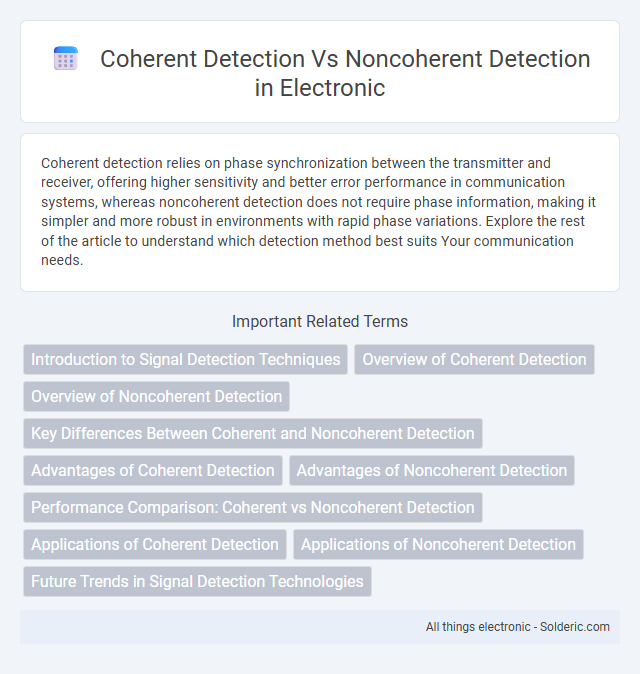Coherent detection relies on phase synchronization between the transmitter and receiver, offering higher sensitivity and better error performance in communication systems, whereas noncoherent detection does not require phase information, making it simpler and more robust in environments with rapid phase variations. Explore the rest of the article to understand which detection method best suits Your communication needs.
Comparison Table
| Feature | Coherent Detection | Noncoherent Detection |
|---|---|---|
| Carrier Phase Knowledge | Requires exact carrier phase synchronization | No carrier phase information needed |
| Complexity | Higher complexity due to phase tracking | Lower complexity, simpler receiver design |
| Sensitivity | More sensitive to phase errors | Robust against phase errors |
| Performance | Better bit error rate (BER) performance | Moderate BER, less efficient |
| Applications | Used in coherent modulation schemes like QPSK, BPSK | Used in frequency-shift keying (FSK), amplitude-shift keying (ASK) |
| Signal Processing | Requires complex demodulation using phase reference | Relies on envelope detection or energy detection |
| Implementation Cost | Higher due to PLL and carrier recovery circuits | Lower, simpler hardware requirements |
Introduction to Signal Detection Techniques
Coherent detection uses phase and frequency synchronization with a reference signal, enabling precise demodulation of modulated waveforms such as PSK and QAM. Noncoherent detection relies on envelope or energy detection without requiring phase synchronization, making it suitable for simpler systems like FSK and ASK under noisy conditions. Signal detection techniques are critical for optimizing communication reliability by balancing complexity, synchronization requirements, and noise resilience.
Overview of Coherent Detection
Coherent detection relies on the precise synchronization of the receiver's local oscillator with the carrier wave of the transmitted signal, enabling accurate phase and amplitude information extraction. This method offers superior sensitivity and lower bit error rates compared to noncoherent detection, making it ideal for complex modulation schemes like PSK and QAM. Coherent detection requires accurate carrier phase recovery, often achieved through phase-locked loops or pilot signals, which increases receiver design complexity but significantly enhances communication reliability and spectral efficiency.
Overview of Noncoherent Detection
Noncoherent detection processes received signals without requiring prior knowledge of the phase, simplifying the receiver design and making it robust in environments with rapid phase variations or low signal-to-noise ratios. Commonly used in frequency-shift keying (FSK) and differential phase-shift keying (DPSK) systems, noncoherent detection relies on energy or envelope detection techniques rather than phase estimation. Your communication system benefits from reduced complexity and lower synchronization requirements, though it may experience a slight performance trade-off compared to coherent detection.
Key Differences Between Coherent and Noncoherent Detection
Coherent detection requires exact carrier phase synchronization to accurately demodulate the received signal, enabling higher sensitivity and better error performance in communication systems. Noncoherent detection, on the other hand, operates without carrier phase information, relying on signal energy or envelope detection, which simplifies receiver design but typically results in lower sensitivity and higher error rates. Your choice between these methods depends on system complexity, power constraints, and the required reliability of signal detection.
Advantages of Coherent Detection
Coherent detection offers superior sensitivity and improved signal-to-noise ratio (SNR) performance compared to noncoherent detection, enabling more accurate demodulation of phase and frequency modulated signals. It allows the use of phase information for detection, which enhances error rate performance in complex communication systems like QPSK and QAM. The technique supports higher data rates and spectral efficiency, making it essential for advanced digital communication standards such as LTE and 5G NR.
Advantages of Noncoherent Detection
Noncoherent detection offers significant advantages in communication systems by eliminating the need for exact phase reference, reducing complexity and power consumption. It provides robustness against phase noise and frequency offsets, making it suitable for environments with rapidly varying channels or low-cost hardware. This method enhances reliability in scenarios where coherent detection faces challenges due to synchronization requirements.
Performance Comparison: Coherent vs Noncoherent Detection
Coherent detection generally offers superior performance compared to noncoherent detection due to its ability to utilize phase information of the received signal, resulting in lower bit error rates (BER) under identical noise conditions. Noncoherent detection, while simpler and less power-intensive, typically suffers from higher BER because it relies solely on signal amplitude or frequency without phase reference. Your system's choice between the two methods depends on the trade-off between performance requirements and implementation complexity.
Applications of Coherent Detection
Coherent detection is widely applied in advanced optical communication systems, radar signal processing, and digital modulation techniques such as QAM and PSK, where precise phase information enhances signal recovery and noise resilience. You benefit from improved sensitivity and higher data throughput in fiber-optic networks and wireless communications by using coherent detection, which enables complex signal demodulation and efficient channel estimation. This method outperforms noncoherent detection in scenarios demanding high spectral efficiency and robust performance under phase distortion.
Applications of Noncoherent Detection
Noncoherent detection is widely applied in scenarios where phase information is unreliable or unavailable, such as in wireless sensor networks and fading channel communications. It enables efficient demodulation of signals in low-power IoT devices, reducing complexity and improving battery life without requiring complex phase synchronization. Your communication system benefits from noncoherent detection in environments with rapid phase variations or multipath effects, ensuring robust and simplified signal detection.
Future Trends in Signal Detection Technologies
Future trends in signal detection technologies emphasize enhanced coherent detection methods leveraging machine learning algorithms to improve phase and frequency estimation accuracy in complex environments. Noncoherent detection advancements focus on energy-efficient architectures and robust modulation schemes for Internet of Things (IoT) and low-power wide-area networks (LPWAN). Integration of hybrid detection systems combining coherent and noncoherent techniques is gaining traction to optimize performance across dynamic communication channels.
coherent detection vs noncoherent detection Infographic

 solderic.com
solderic.com